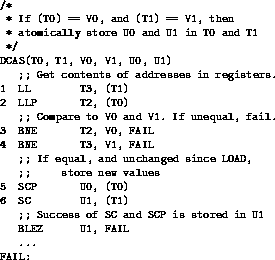



Next: Software Implementation of
Up: The Synergy Between Non-blocking
Previous: Comparison to Blocking
Our approach assumes an efficient implementation of DCAS functionality.
In this section, we briefly outline an instruction set extension to
the load-linked/ store-conditional) instructions
to support DCAS.
(A software implementation is discussed in Section 6.1.)
With a processor supporting load-linked (LL)
and store-conditional (SC) instructions,
add two instructions:
- LLP (load-linked-pipelined): load and link to a second address
after a LL. This load is linked to the following SCP.
- SCP (store-conditional-pipelined): Store to the specified location
provided that no modifications have been made to either of the memory
cells designated by either of the most recent LL and LLP instructions
and these cache lines have not been invalidated in the cache of the
processor performing the SCP.
If a LLP/ SCP sequence nested within an LL/SC pair fails,
the outer LL/SC pair fails too.
DCAS is then implemented by the instruction sequence
shown in Figure 3
(using R4000 instructions in addition to the LL/SC(P) instructions).

Figure 3: DCAS Implementation using LL/ SC and LLP/ SCP .
Success or failure of SC (and thus of the DCAS operation) is returned
in U1 or whatever general register holds the argument to SC.
1 denotes success, 0 failure.
If the next instruction tries to read U1,
the hardware interlocks (as it already does
for LL/SC) if the result of SC is not already in U1.
The LL and LLP instructions in lines 1 and 2 ``link'' the loads
with the respective stores issued by the following SC and SCP
instructions. Lines 3 and 4 verify that (T0) and (T1)
contain V0 and V1, respectively. The SCP and SC in lines
5 and 6 are conditional. They will not issue the stores unless
(T0) and (T1) have been unchanged since lines 1 and 2.
This guarantees that the results of CAS in lines 3 and 4 are still
valid at line 6, or else the SC fails. Further, the store
issued by a successful SCP is buffered pending a successful SC. Thus,
SC in line 6 writes U1 and U0 to (T1) and (T0)
atomically with the comparison to V0 and V1 .
.
We have worked out a detailed design for the implementation of
these two instructions in a RISC processor such as the R4000
but the description is omitted for brevity.



Next: Software Implementation of
Up: The Synergy Between Non-blocking
Previous: Comparison to Blocking
Michael Greenwald
Wed Sep 18 15:42:13 PDT 1996

